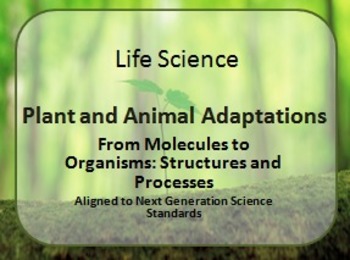Plant and Animal Adaptations PDF Presentation Next Generation Aligned
Melissa Childs
495 Followers
Grade Levels
2nd - 6th
Subjects
Resource Type
Formats Included
- PDF
Pages
75 pages
Melissa Childs
495 Followers
Description
This product contains 75 slides that cover the basic plant and animal adaptations for elementary school students. The slides are aligned to Next Generation Science Standards but will work with any similar science standards across the world.
This is a PDF file which can be viewed via projector or presentation whiteboard with the free downloadable Adobe software from the Internet.
That does not grant commercial rights to this information. All information is researched-based and is my understanding and interpretation of the content. In addition, several diagrams and images are hand-drawn and are not for sale or reuse.
Next Generation Standards Addressed:
Students who demonstrate understanding can:
4-LS1-1. Construct an argument that plants and animals have internal and external structures that function to support survival, growth, behavior, and reproduction. [Clarification Statement: Examples of structures could include thorns, stems, roots, colored petals, heart, stomach, lung, brain, and skin.]
4-LS1-2. Use a model to describe that animals’ receive different types of information through their senses, process the information in their brain, and respond to the information in different ways. [Clarification Statement: Emphasis is on systems of information transfer.]
Topics included are:
Internal and external structures of plants
Inside a plant
Outside a plant
Case Study: Cactus
Plant specifics: Thorns
Carnivorous plants
Pitcher Plants
Plant seeds
Plant specifics: Flowers
Case Study: Pecan Tree
How animals and plants are similar
How animals are alike: Need for food
Case Study: Antelope
Focus on Birds
Focus on Insects
Case Study: Mayfly
Focus on Mammals
Basic camouflage
Animal teeth
Case Study: Platypus
Hibernation
Migration
Case Study: Monarch Butterfly
Adaptation
How animals sense their environment
Echolocation
Animal senses: Eyesight
Animal senses: Taste
Animal senses: Hearing
Animal senses: Electroreceptors
Tie it all together
A model of how an animal reacts to sensory information
This is a PDF file which can be viewed via projector or presentation whiteboard with the free downloadable Adobe software from the Internet.
That does not grant commercial rights to this information. All information is researched-based and is my understanding and interpretation of the content. In addition, several diagrams and images are hand-drawn and are not for sale or reuse.
Next Generation Standards Addressed:
Students who demonstrate understanding can:
4-LS1-1. Construct an argument that plants and animals have internal and external structures that function to support survival, growth, behavior, and reproduction. [Clarification Statement: Examples of structures could include thorns, stems, roots, colored petals, heart, stomach, lung, brain, and skin.]
4-LS1-2. Use a model to describe that animals’ receive different types of information through their senses, process the information in their brain, and respond to the information in different ways. [Clarification Statement: Emphasis is on systems of information transfer.]
Topics included are:
Internal and external structures of plants
Inside a plant
Outside a plant
Case Study: Cactus
Plant specifics: Thorns
Carnivorous plants
Pitcher Plants
Plant seeds
Plant specifics: Flowers
Case Study: Pecan Tree
How animals and plants are similar
How animals are alike: Need for food
Case Study: Antelope
Focus on Birds
Focus on Insects
Case Study: Mayfly
Focus on Mammals
Basic camouflage
Animal teeth
Case Study: Platypus
Hibernation
Migration
Case Study: Monarch Butterfly
Adaptation
How animals sense their environment
Echolocation
Animal senses: Eyesight
Animal senses: Taste
Animal senses: Hearing
Animal senses: Electroreceptors
Tie it all together
A model of how an animal reacts to sensory information
Total Pages
75 pages
Answer Key
Does not apply
Teaching Duration
1 Week
Report this resource to TPT
Reported resources will be reviewed by our team. Report this resource to let us know if this resource violates TPT’s content guidelines.





